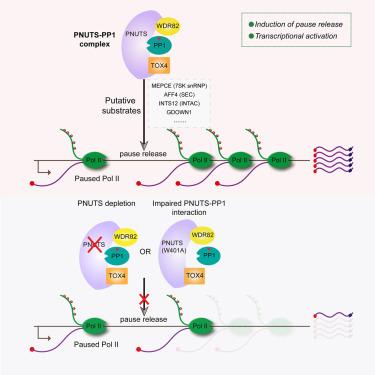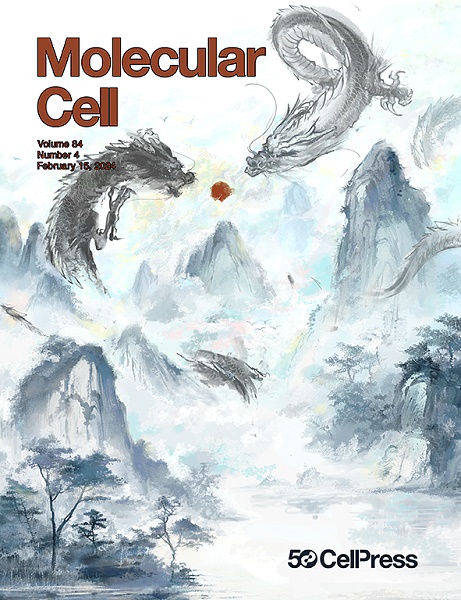The phosphatase PP1 sustains global transcription by promoting RNA polymerase II pause release
IF 14.5
1区 生物学
Q1 BIOCHEMISTRY & MOLECULAR BIOLOGY
引用次数: 0
Abstract
RNA polymerase II progression from initiation to elongation is driven in part by a cascade of protein kinases acting on the core transcription machinery. Conversely, the corresponding phosphatases, notably PP2A and PP1—the most abundant serine-threonine phosphatases in cells—are thought to mainly impede polymerase progression, respectively restraining pause release at promoters and elongation at terminators. Here, we reveal an unexpected role of PP1, within the phosphatase 1 nuclear targeting subunit (PNUTS)-PP1 complex, in sustaining global transcriptional activation in human cells. Acute disruption of PNUTS-PP1 leads to severe defects in the release of paused polymerase and subsequent downregulation for the majority of transcribed genes. PNUTS-PP1 promotes pause release by dephosphorylating multiple substrates, including the 7SK small nuclear ribonucleoprotein particle (snRNP) subunit MEPCE, a known pausing regulator. PNUTS-PP1 exhibits antagonistic functions compared with Integrator-PP2A (INTAC) phosphatase, which generally inhibits pause release. Our research thus highlights opposing roles of PP1 and PP2A in modulating genome-wide transcriptional pausing and gene expression.

磷酸酶 PP1 通过促进 RNA 聚合酶 II 的暂停释放来维持全局转录
RNA 聚合酶 II 从启动到延伸的过程部分是由作用于核心转录机制的蛋白激酶级联驱动的。相反,相应的磷酸酶,特别是 PP2A 和 PP1--细胞中最丰富的丝氨酸-苏氨酸磷酸酶--被认为主要阻碍聚合酶的进展,分别抑制启动子的暂停释放和终止子的延伸。在这里,我们揭示了磷酸酶 1 核靶向亚基(PNUTS)-PP1 复合物中的 PP1 在维持人体细胞全局转录激活中的意外作用。PNUTS-PP1的急性破坏会导致暂停聚合酶的释放出现严重缺陷,进而导致大多数转录基因的下调。PNUTS-PP1 通过去磷酸化多种底物来促进暂停释放,其中包括 7SK 核核糖核蛋白小颗粒(snRNP)亚基 MEPCE,这是一种已知的暂停调节因子。PNUTS-PP1 与整合子-PP2A(INTAC)磷酸酶相比具有拮抗功能,后者通常抑制暂停释放。因此,我们的研究强调了 PP1 和 PP2A 在调节全基因组转录暂停和基因表达中的对立作用。
本文章由计算机程序翻译,如有差异,请以英文原文为准。
求助全文
约1分钟内获得全文
求助全文
来源期刊

Molecular Cell
生物-生化与分子生物学
CiteScore
26.00
自引率
3.80%
发文量
389
审稿时长
1 months
期刊介绍:
Molecular Cell is a companion to Cell, the leading journal of biology and the highest-impact journal in the world. Launched in December 1997 and published monthly. Molecular Cell is dedicated to publishing cutting-edge research in molecular biology, focusing on fundamental cellular processes. The journal encompasses a wide range of topics, including DNA replication, recombination, and repair; Chromatin biology and genome organization; Transcription; RNA processing and decay; Non-coding RNA function; Translation; Protein folding, modification, and quality control; Signal transduction pathways; Cell cycle and checkpoints; Cell death; Autophagy; Metabolism.
 求助内容:
求助内容: 应助结果提醒方式:
应助结果提醒方式:


